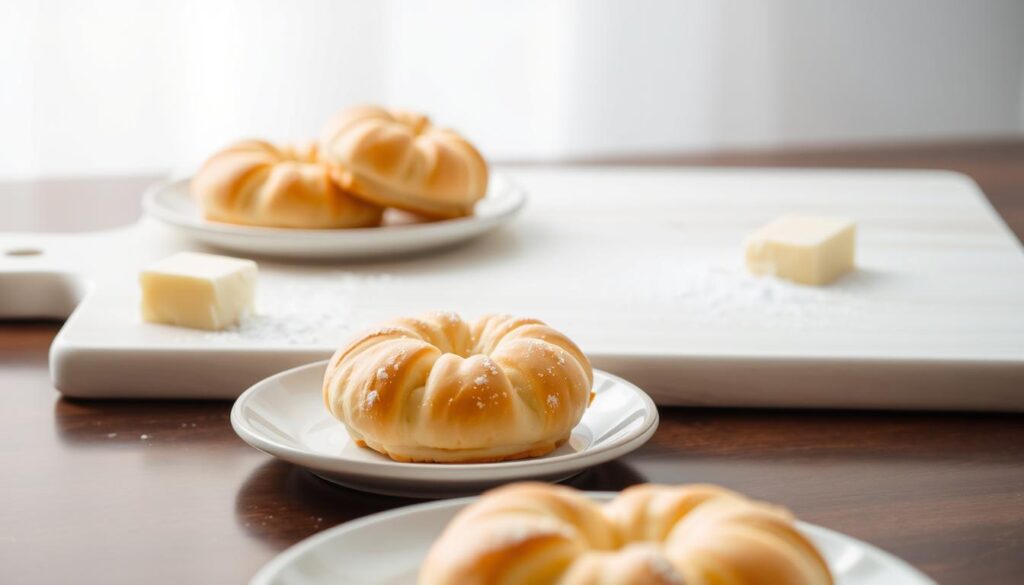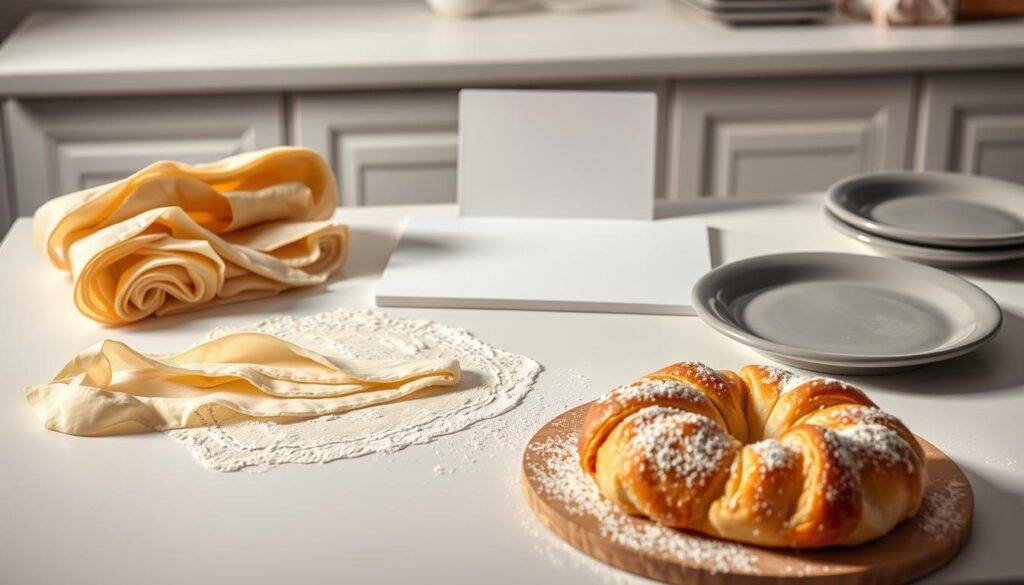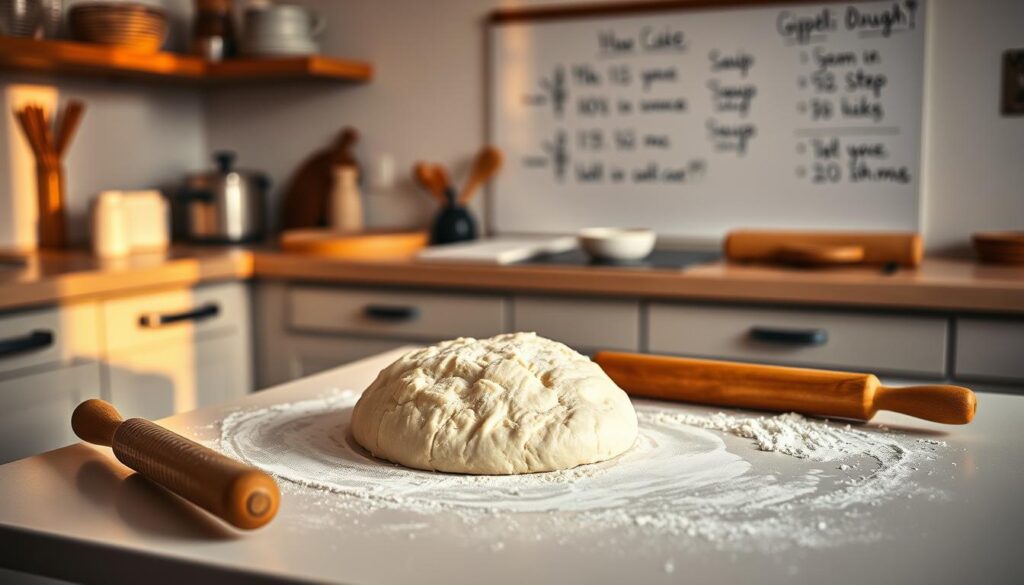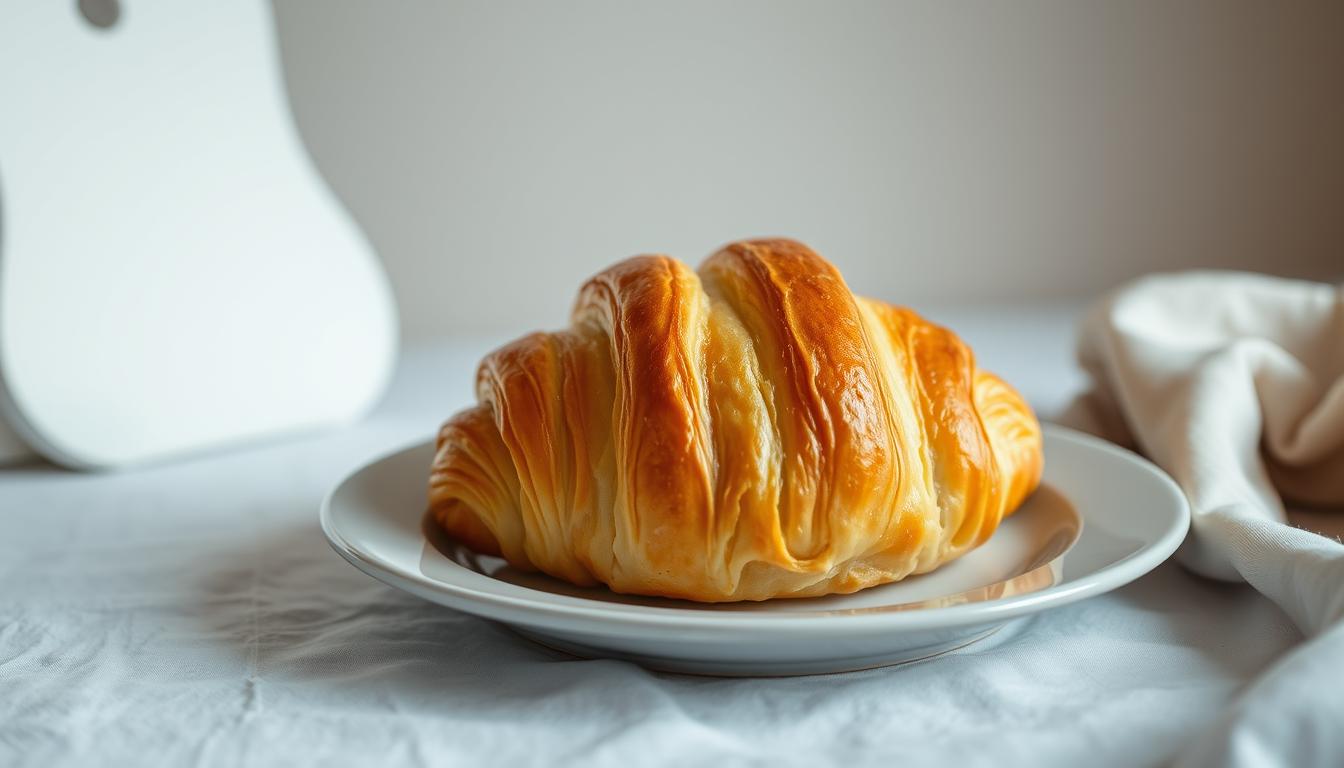The smell of Gipfeli baking in the kitchen brings back Swiss mornings to me. When I eat the flaky, golden pastry, I remember the alpine views and cozy cafes. This Swiss pastry has won my heart, and I want to share it with you.
What’s the difference between a croissant and a gipfeli? Gipfeli is denser and has a special Swiss charm. It’s more than breakfast; it’s a taste of Swiss culture you can make at home.
Making Gipfeli is a fun process that takes about 4 hours and 30 minutes. But don’t worry, most of this time is waiting for the dough to rest. Your effort will be rewarded with 12 delicious pastries that will make your breakfast better.
Key Takeaways
- Gipfeli is a Swiss pastry similar to but distinct from French croissants
- The recipe yields 12 pastries and takes about 4.5 hours to prepare
- Gipfeli has a denser texture compared to croissants
- The pastry requires a specific lamination process for flaky layers
- Proper temperature control is key for perfect Gipfeli
Introduction to Swiss Gipfeli: A Beloved Breakfast Tradition
Swiss Gipfeli is a favorite breakfast treat. It’s a crescent-shaped pastry that’s a twist on the classic croissant. It’s a must-try in Swiss bakeries.
Origins and Cultural Significance
Gipfeli started in the early 19th century. It quickly became a favorite breakfast in Switzerland. People enjoy it with coffee or tea.
This pastry is a big part of Swiss traditions. Making Gipfeli is a family tradition that keeps its charm alive.
Difference Between Gipfeli and French Croissants
Gipfeli and French croissants are similar but different. Gipfeli has less butter, making it denser. They both use flour, yeast, and butter.
Gipfeli can be made with yeast or puff pastry. French croissants use only laminated dough.
| Feature | Gipfeli | French Croissant |
|---|---|---|
| Butter Content | Lower | Higher |
| Texture | Denser | Lighter, flakier |
| Dough Type | Yeast-based or puff pastry | Strictly laminated |
Why Gipfeli Remains Popular in Switzerland
Gipfeli is loved for its taste and versatility. You can enjoy it plain, with chocolate, or almonds. It’s perfect for breakfast or a snack.
In Switzerland, Gipfeli is often paired with coffee, tea, or hot chocolate. This tradition brings people together. Gipfeli is a big part of Swiss culture and daily life.
Essential Ingredients for Perfect Gipfeli
The secret to a good croissant-like pastry is in its ingredients. For gipfeli, you need high-quality parts for that flaky texture. Start with 500g of all-purpose flour for structure. Then, use 250g of cold, unsalted European-style butter for those delicate layers.

Next, add 250ml of whole milk for richness. Include one packet of active dry yeast to make it rise. Sprinkle in 50g of sugar for browning and sweetness. And don’t forget a teaspoon of salt to balance the flavors.
What makes a good croissant or gipfeli? It’s all about keeping the butter cold. This creates flaky layers during lamination. Folding the dough 3-4 times builds a crispy outside and tender inside.
| Ingredient | Amount | Purpose |
|---|---|---|
| All-purpose flour | 500g | Structure |
| Unsalted butter | 250g | Flaky layers |
| Whole milk | 250ml | Richness |
| Active dry yeast | 1 packet | Leavening |
| Sugar | 50g | Sweetness and browning |
| Salt | 1 tsp | Flavor balance |
Remember, the quality of your ingredients matters. Choose the best you can find for perfectly golden and delicious gipfeli every time.
Equipment and Tools Needed
To make tasty Gipfeli, you need the right tools. You’ll need basic kitchen stuff and special baking tools for flaky layers. Let’s see what you need for these Swiss treats.
Basic Kitchen Equipment
Most people already have these basics:
- Large mixing bowl
- Measuring cups and spoons
- Rolling pin
- Baking sheets
- Pastry brush
Specialized Baking Tools
These tools can make your Gipfeli better:
- Pastry cutter or bench scraper
- Dough docker
- Pastry mat
- Oven thermometer
Optional Enhancement Tools
For pro results:
- Stand mixer with dough hook
- Infrared thermometer
- Proofing box
- Digital kitchen scale
When talking about Swiss pastries, you might ask, “What is Mandelgipfel in English?” It’s the German name for almond croissant, a tasty twist on Gipfeli.
| Tool Category | Must-Have Items | Nice-to-Have Items |
|---|---|---|
| Mixing | Large bowl, Measuring tools | Stand mixer |
| Shaping | Rolling pin, Pastry brush | Pastry cutter, Dough docker |
| Baking | Baking sheets | Oven thermometer, Proofing box |
| Precision | Measuring cups and spoons | Digital scale, Infrared thermometer |
Understanding the Lamination Process
The secret to a good croissant, and by extension, a delicious Gipfeli, lies in the lamination process. This technique creates those irresistible flaky layers that make these pastries so special.
The Science Behind Flaky Layers
Lamination involves folding and rolling dough multiple times. This creates distinct layers of butter and dough. As the pastry bakes, the butter melts and creates steam pockets.
This results in the characteristic flaky texture. A typical 3-fold lamination creates 9 layers, while a 4-fold creates 16 layers.

Temperature Control Tips
Maintaining the right temperature is key for successful lamination. Keep both the dough and butter cold, ideally between 60-65°F. Work quickly and use your refrigerator or freezer between folds.
This prevents the butter from melting into the dough.
Common Lamination Mistakes
Avoid these pitfalls to achieve perfect lamination:
- Overworking the dough, which can lead to tough pastries
- Using warm butter, causing it to melt and merge with the dough
- Skipping resting periods between folds
- Rolling the dough too thin, which can tear the layers
| Lamination Method | Total Layers | Butter Layers |
|---|---|---|
| 3-fold | 9 | 4 |
| 4-fold | 16 | 5 |
| 3-4-3 fold | 81 | 12 |
With practice and patience, you’ll master the art of lamination. You’ll create Gipfeli with perfectly flaky layers every time.
Gipfeli Recipe: Step-by-Step Instructions
Ready to make your own Swiss-style croissants? Let’s start the Gipfeli recipe! It’s all about a dough rich in butter, laminated for flaky layers.
First, mix 6 grams of instant dry yeast with 240 ml of warm milk. Add 405 grams of flour, 38 grams of sugar, and 3 grams of salt. Then, mix in 30 grams of softened butter until smooth. Let it rest for an hour, until it doubles.
Next, roll out the dough to 50 cm by 30 cm. Spread 100 grams of cold butter over two-thirds. Fold, roll, and chill for 30 minutes. Do this three times for the best layers.
After the last fold, chill the dough for an hour. Roll it to 4mm thickness and cut into triangles. Shape into crescents and let rise for 25 minutes. Brush with egg wash and bake at 200°C for 15-20 minutes until golden.
| Ingredient | Amount | Function |
|---|---|---|
| All-purpose flour | 405 grams | Base structure |
| Instant dry yeast | 6 grams | Leavening agent |
| Fresh milk | 240 ml | Moisture and flavor |
| Unsalted butter | 130 grams total | Flavor and flaky texture |
| Sugar | 38 grams | Sweetness and browning |
This recipe makes about 12 Gipfeli, great for 10 people. Each serving has 210 calories and 11 grams of fat. It’s a tasty breakfast treat. Enjoy your homemade Swiss croissants!
Mastering the Dough Preparation
Getting the dough right is key to making great gipfeli. Unlike croissants, gipfeli dough is denser. This makes them special in texture and taste.
Mixing Techniques
Begin by mixing 3 cups (362g) of flour with dry ingredients. Add cold water and milk slowly. Mix until a shaggy dough forms.
Add 3 tablespoons of unsalted butter for extra richness. Mix just enough to combine ingredients. Avoid overmixing.
Resting Times and Temperatures
Let the dough rise in a warm spot (75-90°F) for 1½ to 2 hours. This step adds flavor and structure. Then, chill it for 1-2 hours.
This cold rest makes the dough easier to work with. It’s essential for lamination.

Proper Kneading Methods
Gipfeli dough needs gentle kneading. After rising, knead it briefly to spread yeast evenly. Don’t overwork it to avoid tough pastries.
The aim is a smooth, elastic dough. This dough is now ready for lamination.
Mastering these steps is vital for authentic gipfeli. With practice, you’ll see the difference in texture and taste between gipfeli and croissants.
Shaping and Forming Perfect Crescents
Shaping Gipfeli into their iconic crescent form is an art. It needs practice and precision. Start by rolling out the dough into a 24 by 12 inches rectangle. Then, trim it to get a 23 by 11-inch rectangle.
Mark the dough at 3.5-inch intervals along the long side. Also, mark 1.75 inches from the corner on the top long side. Cut the dough diagonally to create 12 triangles, each about 13 inches long when stretched. This step is key for uniform Gipfeli.
To shape each Gipfeli, start at the base of the triangle and roll towards the tip. Stretch the dough gently as you roll. Roll tightly to keep the crescent shape. Place the shaped Gipfeli on baking sheets, leaving 2 inches between each for proofing.
For those wondering “What is Mandelgipfel in English?”, it’s the Swiss version of an almond croissant. You can adapt this shaping technique for Mandelgipfel by adding almond paste before rolling.
| Shaping Step | Measurement | Tips |
|---|---|---|
| Initial rectangle size | 24″ x 12″ | Roll evenly for consistent thickness |
| Trimmed rectangle size | 23″ x 11″ | Trim edges for clean cuts |
| Triangle base width | 3.5″ | Mark accurately for uniform sizes |
| Triangle length | 13″ (stretched) | Gently stretch while rolling |
| Number of triangles | 12 | Yields 12 Gipfeli per batch |
Remember, perfecting your Gipfeli shaping technique takes time. With practice, you’ll create beautifully uniform crescents. They will be as pleasing to the eye as they are to the palate.
Tips for Achieving Golden-Brown Perfection
Baking Gipfeli is like unlocking a secret to a good croissant. The goal is to get that perfect golden-brown color. This makes your taste buds happy. Here are some tips to make your Gipfeli better.
Optimal Baking Temperature
Set your oven to 200°C (400°F) for the best baking. This temperature makes the outside crisp and the inside soft. Using a steam oven, between 175°C to 200°C, makes the crust even better.
Egg Wash Secrets
The egg wash is key for a croissant-like finish. Brush a thin layer over your pastries before baking. This step adds shine and a golden color.
Timing and Visual Cues
Watch your Gipfeli closely as they bake for 15-20 minutes. Look for a golden color and puffiness. The Maillard reaction helps create a great crust. When you smell a heavenly aroma, they’re ready to eat!
FAQ
What is the difference between a croissant and a gipfeli?
What is the secret to a good croissant or gipfeli?
What is a croissant made of?
What is Mandelgipfel in English?
How long does it take to make gipfeli from start to finish?
Can I make gipfeli ahead of time and freeze them?
What’s the best way to store gipfeli?
Can I use margarine instead of butter in gipfeli?
Explore More Delicious Recipes on YumeRecipes!
If you enjoyed this recipe, you’ll love these other dishes: try our comforting Artisan Vegan Jalapeno Cheddar Bread Recipe .For a cozy meal, or whip up some Halibut Fish Taco: The Best Taco Ever Made
for a quick and flavorful dinner. For dessert, indulge in our Fudgy Weed Brownies: The Ultimate Marijuana Edible or try a refreshing Immunity Shots Recipe: Revitalize Your Health . Visit YumeRecipes for even more tasty ideas!

